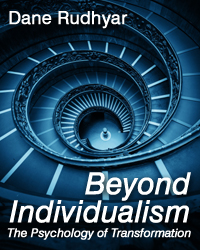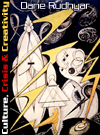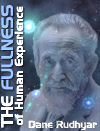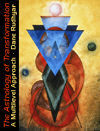Beyond Individualism
The Psychology of Transformation
by Dane Rudhyar
PART TWO:
THE SOCIAL-COLLECTIVE MODE
4. From Biology to Culture
b. The Process of Differentiation
All that has been said so far in this chapter refers to the thesis phase of the process of human evolution. The activity of the functions of the first order is the foundation of human evolution; but when human beings reach the level of the individualized and rational mind, the activity of these biological functions either assumes a secondary role devoid of consciously recognized value—they become a routine matter to which little attention is paid—or they may become compulsive in the manner of psychological complexes because they are repressed. Yet the natural process of human evolution brings this automatic and instinctual activity not only to the level of self-consciousness, but to a transmuted and heightened state. When this state is reached, the fully open and illumined mind sees these biological functions as reflections of a higher cosmic activity.
In order to consciously apprehend this cosmic activity, directly as well as indirectly in its reflections in the microcosm (the human body), the full development of functions of the fourth order is required. These functions constitute the synthesis phase of the dialectical evolutionary process. Between thesis and synthesis stands the antithesis which refers to the Age of Differentiation and Conflicts. During that Age, the development of human society passes through four basic stages, each of which provides specific opportunities for the optimal development of a conscious and intensified approach to one of the four orders of functional activity.
Differentiation is needed in order to bring the various aspects of human nature and human activity to the state of clear, objective consciousness, and to make possible the emergence of autonomous, self-motivated and responsible individuals from the undifferentiated matrix of the species homo sapiens. However, differentiation and individualization imply the development of a sense of separativeness, which leads to pride (or its opposite, shame) and the desire to excel, and almost inevitably at first, to the urge to dominate and rule others. Thus conflicts and war appear. Initially, conflicts between tribal groups simply extend the type of behavior involved in animal and vegetable survival— the need for adequate food and living space. Later on, conflicts between specialized groups within a tribe occur, often fostered by the ambition of men who in some manner have achieved distinction and prestige. Still later, in large cities and within ruling aristocracies, conflicts between individuals hungry for power, wealth and/or sexual conquests become the order of the day.
The stage of 'thesis' in human evolution is one in which human beings are not only active entirely within a natural biospheric environment, but totally pervaded with the rhythms and demands of Earth-nature. Man passively reflects nature and simply seeks to survive and adapt himself as successfully and comfortably as possible to seasonal changes and living conditions. And it seems probable, if not evident, that human beings developed at first in localities where climatic conditions were favorable and the necessities of life were relatively easy to obtain.
The first type of group-organization along strictly biological lines was presumably what has been called the "undivided commune". As the principle of organization was exclusively biological, it most likely took the form of what we define as 'matriarchy' because woman, as mother, was the source of renewed life and thus the great symbol of 'Nature'. Human activity operated exclusively at the level of the first order of functions— thus at the animal level. Yet the seed of the development of higher functions was already latent in mankind. Some external factor may have been required to fecundate this seed with the power of the self-conscious and potentially individualized 'mind'; and it is to that factor that I have referred in the preceding pages.
What we are dealing with here is the transition from the functions of the first order to those of the second order—from 'biology' to 'culture'. In the preceding chapter, I associated this transition with the development of sex. But sexuation at the strictly biological level—seasonal and totally instinctual sex—is essentially different from human sexuality. The fact that in human beings sex is 'a-seasonal' and can be induced at will by what we call imagination—a mental stimulant with immense, even if latent, power—has enormous consequences. So also has the development of an erect spine and especially of formed hands— factors related to the development of human sexuality.(1)
It may indeed be that the reason why according to Genesis 6:2 the Sons of Elohim married the daughters of men is that these spiritual-mental beings introduced, not only the centralizing power of 'self-consciousness' into the purely biological mentality of early mankind (the Promethean gift of 'divine fire'), but with it also the power of imagination. The power of imagination was what, when connected with the sexual function, transformed animal sex into human sexuality. It also gave to man the ability to think in terms of symbols and, as a result, to transform animal cries .and other forms of animal communication into human language and symbolic dance and music. These transformations made possible the development of socio-cultural activity and complex societies.
The impregnation of animal sex with the dynamic and transforming power of the imagination freed human sexuality not only from subservience to seasonal imperatives, but from strictly biological and reproductive purposes. If we believe occult traditions, it led to the magical use of sex and, when degenerated, to 'black magic' and the downfall of 'Atlantis' (whatever was meant by that name). But we do not have to believe such traditions to understand how the non-exclusively biological, imaginative and symbolical development of human sexuality affected the progress—and in some instances, the regression and decadence—of human cultures and societies.
The growth of functions of the second order, the development of agriculture, cattle-raising and, even more, primitive industries requiring the use of fire and metal must have inevitably led from matriarchy to patriarchy. Where superior beings 'married the daughters of men' male dominance may have acquired a special character which presumably led to the formation of a true theocracy. Such a theocracy—if we can take for granted its existence—should be clearly differentiated from much later developments associated with the rule of a culturally institutionalized priesthood to which the name of 'theocracy' is also given.
A priesthood is an organization of men who control sociocultural processes in the name of gods or God. The priests, in most cases, do not claim to belong to a 'divine race' distinct from the ordinary human race; they claim the right and duty to perpetuate the teaching of divine beings and to impose upon the culture-whole the commandments and ordinances given by God or His messenger. They preserve what has been released in the more or less distant beginning of a human cycle. A high priest usually claims the ability to communicate mystically or clairaudiently with divine beings and especially to dispense some of their power, but he is not personally a god. However, a true theocracy apparently existed in ancient Egypt because the Pharaoh and his family were definitely considered to belong to a divine race. The same situation was also found in the Inca society in Peru.
In more recent times, we have seen in Japan an imperial dynasty claiming direct descent from creative gods who have been represented in a form suggesting that they belonged to an ancient race of tall beings with much hair and long beards. (The Ainus of the northern islands of Japan may be the last descendants of such a race which probably came from Siberia.) In recent years, however, the members of the imperial family of Japan certainly have lost the characteristics of the supposedly divine race; yet the claim to divinity, accepted by even educated people until Japan's collapse in World War II, remained a powerful factor in Japan's culture. It was nevertheless a 'socio-culturalized' factor revived after the transformation of Japan—a symbol of cultural superiority consciously or semi-consciously meant to balance or counteract the factual power of an encroaching, materialistic Western society.
What was not only accepted as a self-evident fact in the precultural period—the fabled Golden Age when, according to Greek tradition, gods walked among men—may be retained when the Age of Differentiation and Conflicts begins; but it is retained and used as a powerful symbol of integration. A society developing strictly at the level of functions of the first order operates in terms of what, to its members, are 'facts'. When these facts lose their character of self-evident, or unquestionably perceptible, reality—when they become memories to which a deep symbolical meaning is attached—the stage of 'thesis' is passed. Tribal unanimity of itself, no longer factually exists; it has to be perpetuated in some manner by a type of men acting as preservers of a glorified past. What was an inner, psychically compulsive, and quasi-instinctual reality becomes increasingly more conscious—and later on, resented—subservience of differentiated personalities to a code of laws and a divinely sanctioned tradition.
A somewhat analogous situation exists in the traditional family and the relationship between children and parents. The newborn child is psychically one with the mother. The infant's organism still vibrates in a kind of unison with his progenitors; he is still psychically enveloped, especially when breast-fed, by the mother's electro-magnetic field—a psychic womb. One may speak of the utter devotion of the baby to his mother and call it 'love', but it is not love in a strictly human and conscious sense because it is the compelling manifestation of a biopsychic fact. Sooner or later, the psychic umbilical cord becomes thin, or it may suddenly break. Yet the combination of strong memory-patterns, habit and a deep sense of insecurity—plus the pressure of parental authority and fear of punishment—usually forces the relationship of the child and his parents to retain for some time what may superficially appear to be the same kind of devotional aspect.
The character of this relationship nevertheless has changed; from biopsychically factual and unquestionable, it has become socio-cultural and open to question. It is increasingly being molded by religion and cultural tradition—a particular way of life. As this happens, the probability—and always to some extent, the inevitability—of conflicts begins to manifest. The process of differentiation has started. It takes the form of the growth of the ego-function; and after the mental faculties and the discursive, argumentative intellect develop, individualization gradually takes place.
Then the exercise of social and physical control has to begin in order to manage the centrifugal and potentially explosive development of a myriad of ego-wills. The necessary control is exercised by men of physical power and intense will—that is by a 'warrior caste'. When, later on, mental forces begin to increasingly operate in the people upon whom patterns of physical order and group security have been imposed by the 'strong men' of a turbulent and formative period, another class of human beings is called upon to build mental patterns of order and security. These are needed to keep increasingly eager, question-ing—and thus potentially doubting—minds within a socio-culturally safe realm of enquiry and investigation. This new class of human beings uses the collective memory-remains of the precultural Age (the 'thesis' phase of human evolution) to build a system of intellectual control. This system depends upon clearly formulated dogmas (or paradigms), emotionally inspiring symbols and myths, and the periodic experience of participation in rituals—both religious and, later on, socio-cultural—during which the root-unity of the community becomes an evident fact of consciousness.
The combination of these factors at the intellectual, emotional, and physical levels of human activity keep the development of a culture-whole within a particular area referring to only one of the many potentialities inherent in the human species. The men who perform this function form a priesthood; and institutions of philosophical and scientific learning are built whose essential purpose is to define, strengthen, and deepen—but also inevitably to limit—the special character of the society and its culture.
After a while, when this work has been performed, other forces come into play within the social organism. A new type of activity gradually attains prominence. Its nature and purpose is to expand the field of the culture-whole by the medium of 'commerce'—that is, through the interplay and eventually the merging of various types of human beings and diverse culture-wholes. A 'merchant class' rises to power. It contains within its activities the germ of its downfall—as every class actually does. This leads to the last phase of the Age of Differentiation and Conflicts.
The nature of this phase is complex and little understood, because it marks the possibility of a basic change of level—either in terms of biological, cultural, and spiritual disintegration, or, a radical transformation of human existence. Such a transfor-mation is possible only to individuals and groups of individuals who learn to operate—even if only hesitantly and at first confusedly—at the level of functions of the fourth order.
I shall now briefly outline some of the most characteristic manifestations of the four phases through which a culturally organized social collectivity of human beings passes during the Age in which opportunities are provided to develop differentiated capacities and skill, but also during which conflicts inevitably arise when a dynamic and transformative minority comes to embody the adequate answer to a new evolutionary need and succeeds in controlling the social mechanisms of power and productivity.
1. In old Hindu books, our present phase of human evolution is described as the period of "hand-power and sex difference" [cf. Bhagavan Das, The Science of Social Organization (Adyar, Madras: Theosophical Publishing House, 1910)]. Return
Patterns of Differentiation and Conflict
Copyright © 1979 by Dane Rudhyar.
All Rights Reserved.
See Notices for full copyright statement and conditions of use.
Web design copyright © 2000-2004 by Michael R. Meyer.
All Rights Reserved.






